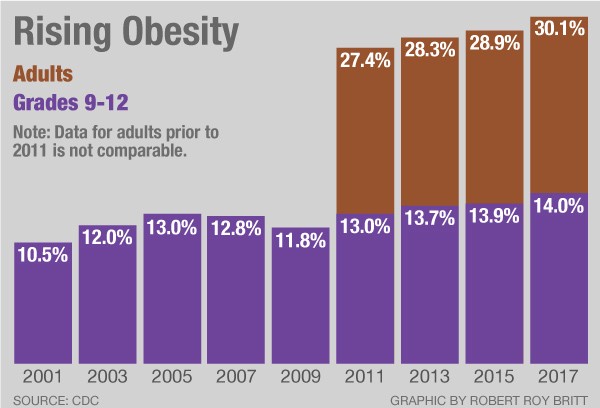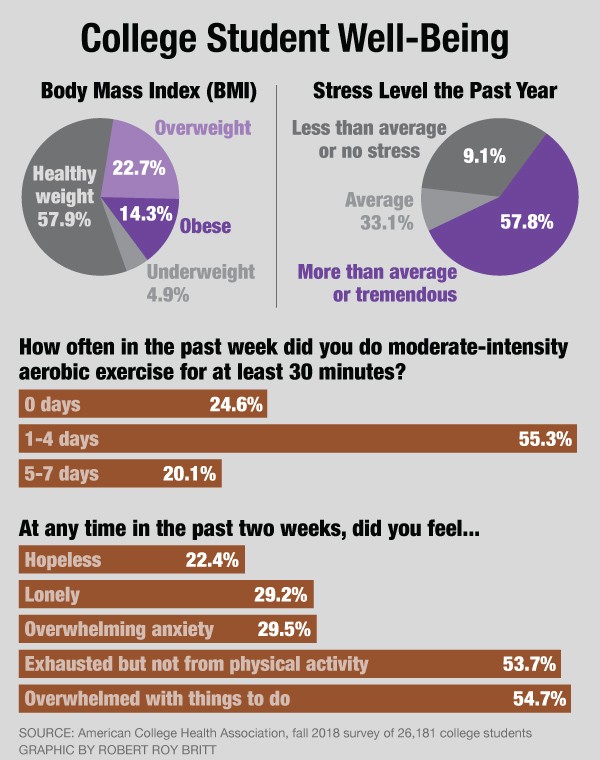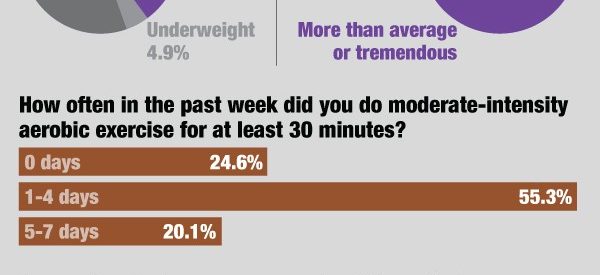Any parent of a fidgety kid knows that forcing a student to sit in a classroom several hours a day with little or no physical activity is a recipe for poor academic performance and lots of notes home from the principal. Our youngest son endured a K-12 education in which recess was rare and PE largely nonexistent. ?No kid ever wants to sit still for five minutes,? he says now, weeks away from high school graduation. ?Let alone seven hours.?
Science is on his side.
The benefits of physical activity on health, mental well-being and brain power for children and adults are well established. Almost any physical activity can make people smarter, studies show. And exercise has been clearly shown to improve academic performance among K-12 students.
Meanwhile, an emerging body of work indicates physical activity can improve GPA for university students and may also reduce dropout rates. Research also suggests that exercise habits picked up from adolescence through college tend to stick with people for life.
Armed with all this evidence, an increasing number of researchers, educators and health advocates are calling for the return of PE in K-12 schools and even favor mandating physical-education instruction at the collegiate level.
?I think all students could benefit from a physical education course in college,? says Kerri Vasold, a Michigan State University researcher who led a study on the topic published Feb. 25 in the Journal of College Student Retention.
At the end of their freshman year at MSU, students who played intramural sports had a 3.25 GPA, compared to 3.07 for those who didn?t play, Vasold and her colleagues found. The students also dropped or failed fewer classes, and they were 40% more likely to return in the fall as sophomores.
The study does not show cause-and-effect, the researchers say, but they did control for high school GPA, gender, race, socioeconomic status and other factors.
?Students who are considered sedentary may not have found a type of activity that they enjoy yet because maybe it wasn?t offered to them in high school,? Vasold says in an email. ?So, a course that re-introduces students to all types of activity, including non-traditional sports and lifelong activities, could really make some major impacts in getting students active and hopefully sustaining that level of physical activity beyond graduation.?
A separate study done in 2017, with similar controls, involved 21,000 college students. Compared to sedentary students, those who got one hour a week of physical activity saw a 0.06 improvement in GPA, and the odds of graduating increased. The effect was compounded for students who exercised twice a week, and again for those who added a third day of physical activity.
For college couch potatoes who add three hours per week of exercise, the odds are their GPA will jump by 0.18, ?which is a major impact,? says study leader Heather Sanderson, an assistant professor of nutrition, health and human performance at Meredith College in North Carolina.
And the effects go beyond grades, Sanderson and her colleagues write in the Journal of Student Affairs Research and Practice.
The impact of physical activity on college students ?begins with the cognitive and neurological response to exercise, alleviating signs and symptoms of anxiety, depression and stress, she says. ?It creates a sense of community and connection with others, and creates life-long health behaviors.?
Many Benefits of K-12 PE
The need for more physical activity is even better documented for K-12 students.
A 2017 review of 26 studies in the United States and 10 other countries and involving more than 10,000 children, published in the journal Pediatrics, concluded: ?Physical activity, especially physical education, improves classroom behaviors and benefits several aspects of academic achievement, especially mathematics-related skills, reading, and composite scores in youth.?
In 2016, 24 experts published a statement in the British Journal of Sports Medicine on physical activity?s effect on students age 6 to 18. Among their conclusions:
- ?Physical activity and cardiorespiratory fitness are good for children?s and young people?s brain development and function as well as their intellect.
- ?A session of physical activity before, during, and after school boosts academic prowess.
- ?A single session of moderately energetic physical activity has immediate positive effects on brain function, intellect, and academic performance.?
Separate studies on students in New Zealand, South Korea, Finland and the UK have all shown that kids who are more physically active get better grades.
Yet a different report in the British Journal of Sports Medicine found that U.S. children age 9 to 17 rank 47th out of 50 countries studied for overall fitness, based on aerobic tests done on 1.1 million children.
?If all the kids in the world were to line up for a race, the average American child would finish at the foot of the field,? said Grant Tomkinson, senior author of the study and an associate professor at the University of North Dakota. Tomkinson and his colleagues depict such a hypothetical race in this graphic:
 Credit: Children?s Hospital of Eastern Ontario
Credit: Children?s Hospital of Eastern Ontario
Meanwhile, PE has been reduced or dropped at K-12 schools across the country.
- York, Pennsylvania eliminated art, music and physical education classes in elementary schools several years ago.
- Illinois changed state law in 2017 to require PE in public schools just three days a week instead of five, and to exempt kids who are involved in interscholastic or extracurricular sports.
- Cuts to arts and PE programs by Oregon public schools are among the reasons teachers there walked out in early May.
Ironically, Oregon was the only state, along with the District of Columbia, that met national recommendations for weekly PE time, according to a 2016 report from the Society of Health and Physical Educators (SHAPE). Only 39 states actually require elementary school students to participate in physical education, and 44 states require it in high school.
In another irony, school officials often blame the lack of PE on the need to perform on standardized tests.
For many schools, reduced funding is at the root of the problem. Most states invest less in K-12 schools today than they did in 2008, according to the National Education Association, despite an increase of more than 1 million students across the country in the past decade. The NEA says physical education programs have recently been on the chopping block, or likely will be, in several states.
PE is not for every student, of course. Children with certain physical or mental health conditions need the opportunity to opt out.
But overall, parents have long recognized the need for PE. In a 2013 poll, 28 percent of parents of K-12 children gave their schools a grade of C, D or F on whether sufficient time was devoted to physical education, and 68 percent said their child?s school does not provide daily PE.
?Parents should let their state boards of education and their local school districts know that they want more PE for their kids, and encourage state and local policy-makers to provide the necessary resources for full implementation,? says Dwayne Proctor, director of childhood obesity research at the Robert Wood Johnson Foundation.
Inactivity doesn?t just hurt academic performance. It?s also blamed for rising rates of obesity among U.S. children.

Meanwhile, the estimated number of children with attention deficit hyperactivity disorder increased from about 4.4 million in 2003 to 6.1 million in 2016, or 9.4% of children ages 2?17, according to the CDC. And yet we?ve known since 2012, from a study in the Journal of Pediatrics, that kids with ADHD can focus on school tasks better after a single session of exercise.
?Exercise might be a tool in our nonpharmaceutical treatment of ADHD,? says Matthew Pontifex, a Michigan State University researcher who led the study.
The health benefits of exercise are many. ?Compared to kids who are inactive, physically active kids have improved cardiorespiratory and muscular fitness,? according to a SHAPE report. ?Kids? physical activity is also linked to better bone health and muscular fitness, and physical activity promotes a healthier body weight and body composition.?
Habits Set for Life?
The increasingly sedentary lives of K-12 students, and the lack of required PE classes, sets kids up for a lifetime of inactivity.
A study in the American Journal of Health Promotion found that students ages 12?15 who have PE in school hold more accurate ideas about the amount of physical activity needed for good health.
?The junior high/middle school years are a vulnerable and pivotal time in which students are typically required to take at least some physical education for at least part of the year, whereas after their freshman year in high school, most students aren?t required to take any,? says study team member Brad Cardinal, a professor at Oregon State University. ?It?s a time when experiences in physical education and sports, whether positive or negative, can make or break whether an adolescent chooses to continue a physically active lifestyle.?
Other research finds that physical activity tends to decline as students go from high school to college, setting a pattern that then tends to persist for a lifetime, says Cardinal, who is president of the National Academy of Kinesiology. He, too, thinks universities should require physical-education courses.
?Past studies have shown that having a requirement in college is beneficial down the road,? he says. ?Essentially, those studies? show that students who aren?t physically active in college tend to remain inactive later in life.?
Just how out of shape are college students?
The American College of Sports Medicine and the American Heart Association recommend adults get at least 30 minutes of moderate-intensity aerobic exercise at least five days a week. The majority of university students fall short of that threshold, robbing themselves not just of the GPA benefits but a chance at improved overall health, better sleep, lower stress and opportunities to socialize.

Cardinal gets downright philosophical when addressing the many reasons higher education should embrace PE.
?As a social institution, colleges and universities generally employ human development models, which encompass the full spectrum of student health and wellness,? he says. ?This includes multiple dimensions, such as career, emotional, environmental, intellectual, physical, social, and in some cases [as with religiously affiliated institutions] spiritual.?
Yet as of 2012, fewer than 40 percent of colleges and universities in the United States had any PE requirement, Cardinal and his colleagues determined. No similar study has been done since, he says, and he figures the estimate likely holds true today. And in research published last year in the Journal of American College Health, his team found that offering physical education classes as electives tends to attract only students who are already motivated, whereas requiring the courses gets students off the couch.
Not requiring PE ?neglects a large group of students who are inactive and unmotivated and who could benefit immensely,? Cardinal says.
Sanderson, the Meredith College researcher, thinks of exercise in terms of both long-term cognitive benefits and immediate rewards. Cardiovascular exercise such as cycling, brisk walking or jogging and swimming have ?the best impact on the brain over time,? she says. ?Short term, such as if a student needs to study or take a test, they should do no more than 30 minutes of low-moderate activity ? yoga, walking, tai chi ? right before the cognitive activity to see best results.?


